Winter Fishing
CATCHING CARROTS
As Nick Jones sat at home on a cold day scrutinising the charts for likely looking swordfish spots, his wife Brooke asked him, “When are you going gurnard fishing again?” He almost felt guilty – “How could I have forgotten my humble winter companions?”
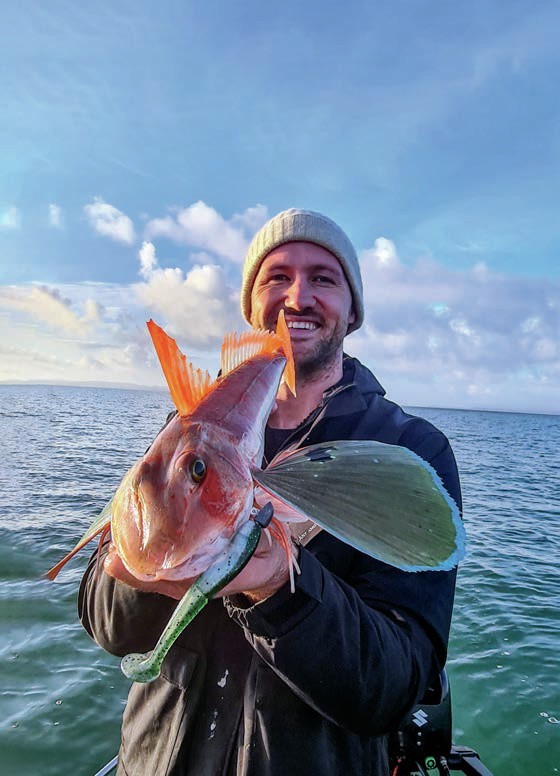
Ihave a natural affinity for carrots – one of my best fishing mates is a red-headed specimen and I’m a big fan of an orange slowjig. While much less exciting than goliaths of the deep, gurnard (or carrots as many Kiwi anglers affectionately call them) are a fun and tasty fish to target. You also don’t need to go miles to snag a few.
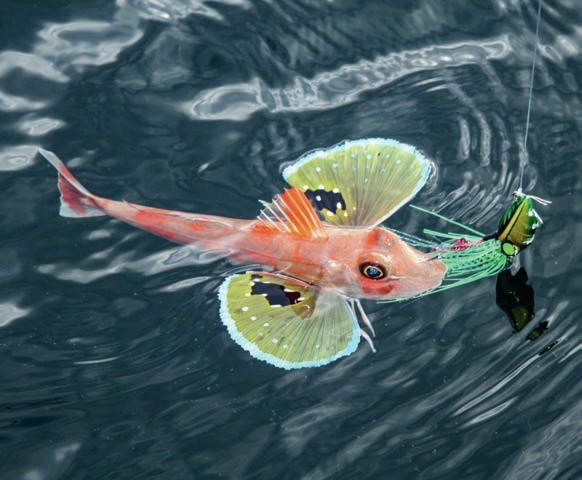
This gurnard took a slow jig in 80 metres of water. Photo: Grant Dixon;
Gurnard are a bottom dwelling species and tying the sinker close to the bottom hook often reaps rewards;
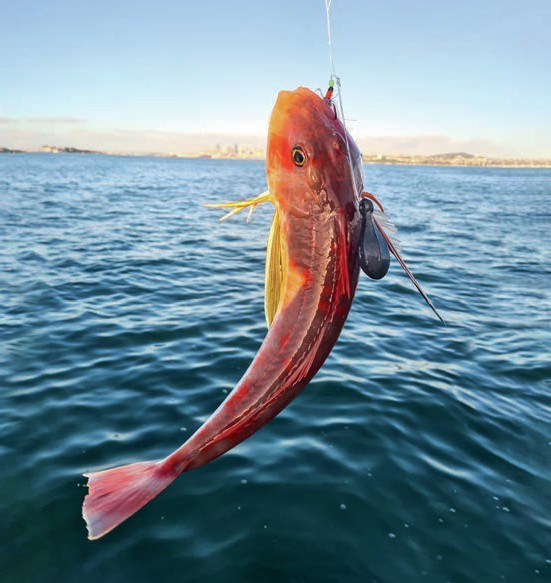
Locations and seasons
Partly due to constrained lockdown (and fatherhood) fishing options, I’ve spent a fair few days over the last two years targeting gurnard, and I can confidently say they are a very accessible fish for any NZ angler. They can be caught year-round basically anywhere there’s saltwater, and they’re distributed right around our great country. In a convenient radius from my house in Auckland, I’ve caught them from the shore off the container wharf breakwater; Ladies Bay (watch for nudists!); Muriwai Beach; and off the kayak or boat in a range of spots in the Waitemata, Manukau and Kaipara Harbours, and the Hauraki Gulf. But the best gurnard session I ever had was off a little kayak along the Mahia peninsula south of Gisborne – they were practically slithering into the ‘yak that day.
Although you can encounter carrots in plenty of environments, if you want to have a good ol’ fashioned carrot harvest then there are a few factors to take into consideration. Winter and early spring is hands down the prime time to target gurnard in the harbours. Apparently, they spawn in spring and early summer, so they probably start congregating and feeding up hard in preparation for the action.
Gurnard feed on crabs primarily and like to stalk along flat sandy or muddy bottoms. If fishing off the back of surf beaches, I find depths of around 10-20m favourable. However, if you’re fishing a harbour, it’s more a case of targeting the channel edges or the shallower guts and flats, depending on the tide. Gurnard come right up onto the mudflats with the rising tide, so don’t be afraid to fish in just a few metres of water in the harbours.
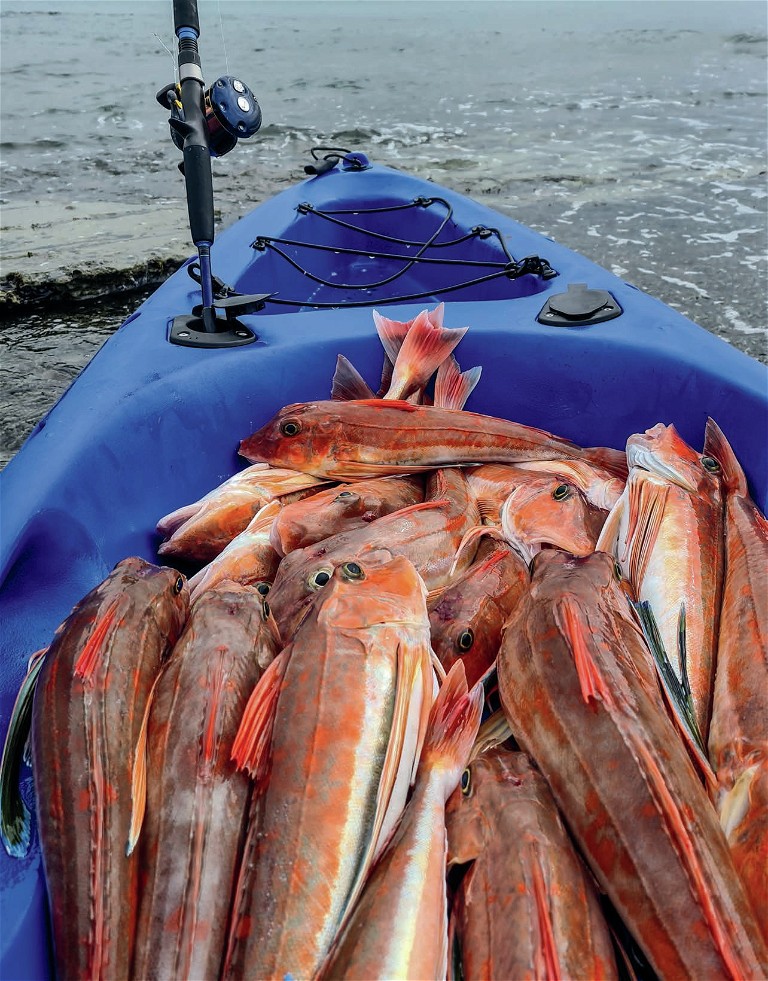
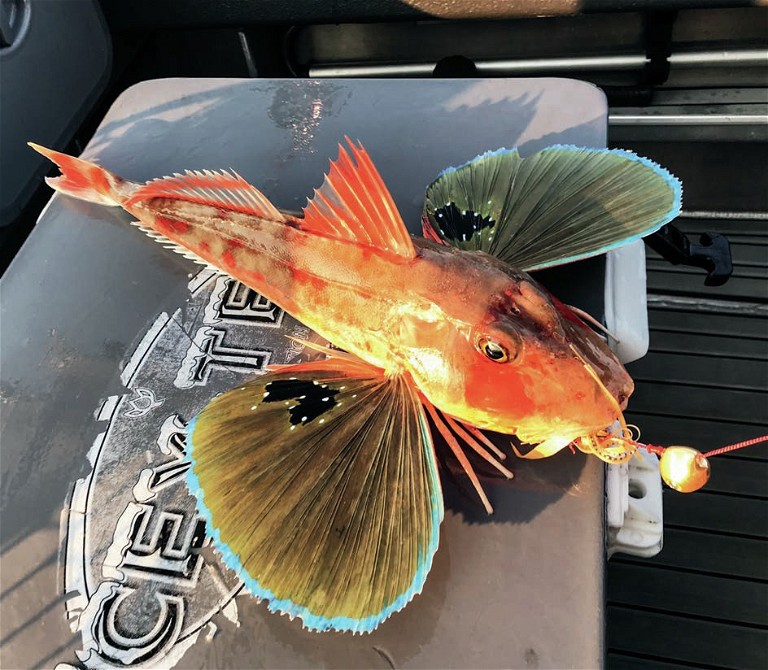
You don’t need a big boat to track down gurnard. : Gurnard are suckers for an orange slider. Photo: Grant Dixon;
10 GURNARD PRO TIPS
• Winter and early spring is hands down the prime gurnard time.
• In a harbour, target the channel edges or the shallower guts and flats.
• On the east coast, have the current flowing.
• In the west coast harbours, slack tide is best.
• Light soft-baiting sets are perfect for targeting gurnard in the shallows.
• A5/0 recurve hook pink flasher rig is a consistent performer.
• If surfcasting, a breakout sinker will keep the baits in the zone.
• Skipjack tuna, fresh mullet or kahawai are baits of choice.
• Gurnard heads and frames make an amazing fish stock.
• Aberley bag tied to the anchor chain normally helps attract bites.
On the east coast I prefer the current flowing, but in the west coast harbours, slack tide is best.
Not only is it much easier – from a practical point of view – to fish when the current isn’t ripping past, but gurnard seem to be more active and hungrier around slack water. As an example of these factors: my favourite carrot hangout is in about 5m of water, at high tide, in a shallow gut that leads up to mudflats in the Kaipara Harbour, in the middle of winter.
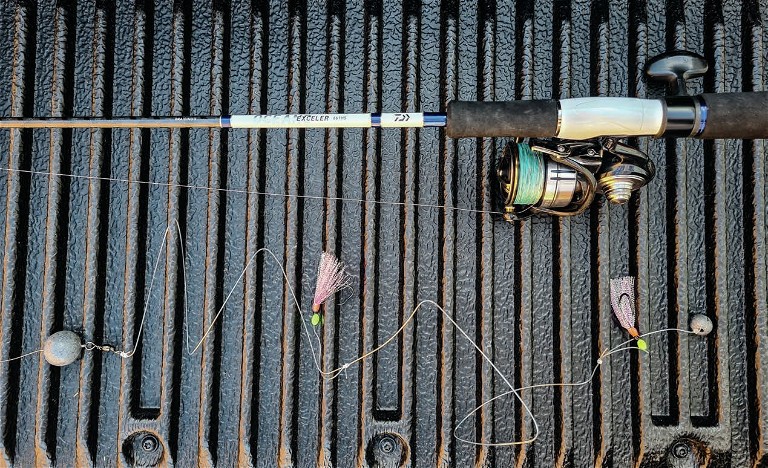
The author’s favoured carrot rig – note the two sinkers to keep baits on the bottom.
Gear and techniques
Gurnard catching is not rocket science, but a few little things can increase your catch rate (and this can be important if the slack tide bite time at your spot lasts for less than an hour!).
I find light soft-baiting sets perfect for targeting gurnard in the shallows. The light braid produces less vibration in the current than thicker lines, and a sensitive tip helps you feel the often-subtle carrot nibbles. And best of all, a big carrot can pull some string from a lightweight combo, giving you some heart-inmouth excitement!
At the business end, it’s hard to go past a 5/0 recurve hook pink flasher rig. I like to tie the sinker close to the bottom hook to account for the gurnard’s mudhugging nature. If surfcasting, a breakout sinker will help keep the baits in the strike zone. But, an even better rig for boat fishing is to tie a small sinker at the base of the flasher rig and have a larger sinker sitting above the swivel.
This allows all of the baits to sit hard on the bottom in the prime carrot zone. Just watch out for tangles with this set-up when the kahawai are flowing!
Although gurnard have relatively big mouths, I like using small triangles of skipjack tuna hooked through the skin once.
On their upper jaw they have a bony plate, so you don’t want to choke the point of the hook with bait and risk not being able to penetrate this. Fresh kahawai or mullet baits also work well.
A berley bag tied to the anchor chain normally helps drag in a few orange customers – just be judicious with it (on the west coast particularly) as spiny dogfish can be a nuisance. Lures also work for carrots: small soft-baits dragged along the bottom, or sliders worked slowly (or even left in the rod holder) can work fairly well.
I like to fish two rods when I’m carrot fishing to make the most of the short slack-tide bite times – one cast a bit behind the boat, and one simply dropped straight over the side. With my activelyfished rod, I like to keep a bit of slack in the line to ensure the baits stay as close to the bottom as possible and to give the fish time to suck down the bait. When you’ve had a good nibble, it is then simply a case of slowly lifting the rod to set the recurve hooks; then put the gimble on and get the flying gaff ready…
Just kidding. But once you’ve got a bunch of carrots on ice in the chilly bin, make sure to get your tastebuds ready because you’re in for a real treat. We enjoy panko-crumbed gurnard with a side of Japanese mayo the most, but if you’re willing to put in a bit of effort, the heads and frames make an amazing fish stock. This stock can be used as the base for seafood chowders to warm both you and the cockles of your heart during those long winter nights. Now, go get yourself some mighty gurnard!